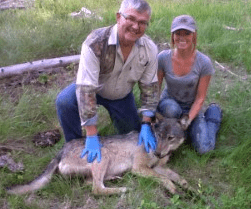Share this article
Kleberg Award recipient develops dynamic working group process
The publication of Utah’s Conservation Plan for Greater Sage-grouse in 2013 will be remembered as a major turning point in the history of the species’ conservation and management in the state. The plan, Utah’s first statewide coordinated effort to manage sage-grouse, would not have been possible without two decades of applied research and community involvement by Dr. Terry Messmer, and his students.
Messmer’s vision of collaboration between the state of Utah and numerous stakeholders resulted in the development of a dynamic community-based conservation adaptive resource management local working group process (LWG). This vision, turned into a reality, has led to better land management decisions for the conservation of wildlife species including but not limited to sage-grouse. For his leadership in implementing the Utah Community-based Conservation Program (CBCP), and its strong focus on engaging the local communities most affected by conservation in applied research, he was recognized by The Wildlife Society (TWS) with the 2016 Caesar Kleberg Award for Excellence in Applied Wildlife Research.

©Terry Messmer
“From my standpoint it’s pretty humbling,” said Messmer, Director of the Jack H. Berryman Institute at Utah State University and longtime member of The Wildlife Society. He is also a professor and extension wildlife specialist at the university and the CBCP Director. In reflecting on the work of Caesar Kleberg and the past recipients of this award, Messmer points out that all had strong ties to relating their research back to on-the-ground wildlife management. “The research that they did made a difference in the conservation and management of wildlife, in particular in the lives of those most affected by species conservation policies.”
Along the journey toward collaborative resource management, especially at the local level, Messmer has taken pride in seeing communities and local leaders take greater ownership and pride in the outcome and develop a greater appreciation for the role of science and research in management.
But his greatest sources of pride are his students. Many are now in positions of influence with state and federal agencies, while others are employed by universities. But all have become ambassadors for the role of applied research in management, and engaging local communities in the process. Throughout his career and the careers of his graduate students, Messmer has always emphasized the importance of incorporating landowners into the application of research and making them understand why it’s being done.
“Having [former students] submit the nomination was very rewarding because ultimately when you look at wildlife management, the secret of successful wildlife management is building that sound foundation,” he said. “I think that—more than anything—is the real legacy of The Wildlife Society. It provides a network of continuity for wildlife management.”
Messmer will continue his sage-grouse work through the CBCP, the Berryman Institute, and the local working group community. The true focus of these entities is to better manage human-wildlife conflict. According to Messmer, adaptive resource management local working groups are developed with the idea that these groups can devote their time, talent and treasuries to other issues or conflicts that arise regarding natural resource management. He leaves wildlifers with a few words of sage advice he received from former Idaho Governor Cecil Andrus who was also President Carter’s Secretary of Interior; 1.) always tell the truth, and 2.) before you make an important policy decision, make sure you have a clear understanding of how that decision will ultimately affect those who have the greatest potential to be impacted.
“Ultimately, this is what conservation is about,” Messmer said, “Mr. Kleberg, advocated for managing wildlife for the right reasons and using the right way. The only way you can do that is if you’ve access to information obtained through applied research programs implemented at the community level.”








